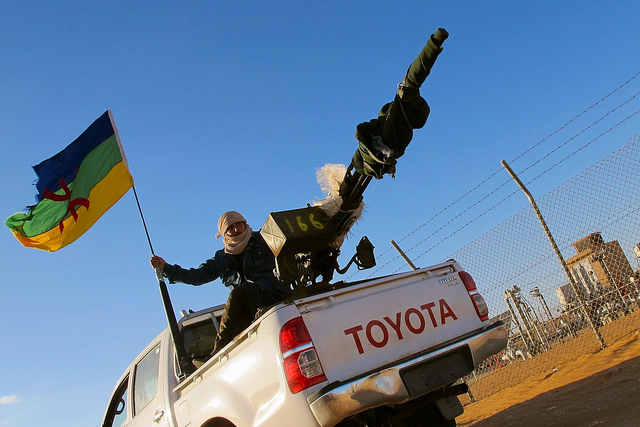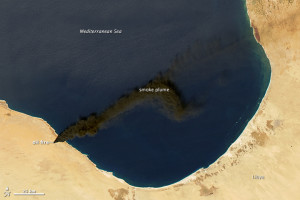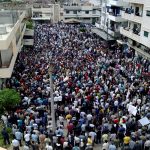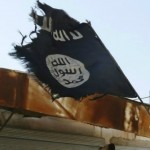by Wayne White
The Libyan National Oil Corporation (NOC) ended on January 2 a fire that raged for days among tanks in Libya’s largest oil export terminal of Es-Sider, but the militia violence fed by the implosion of governance that caused it continues. Indeed, the levels of suffering, civilian casualties, refugees, and those internally displaced have increased steadily. The talks between Libya’s rival warring governments slated for today have been postponed. Meanwhile, extremist elements are taking greater advantage of the ongoing maelstrom.
The NOC managed to put the fire out, but three days of normal Libyan oil exports were destroyed. Of course, with Libyan crude exports already down to less than 400,000 barrels per day (only 1/3 of normal output), the fire’s impact on global markets was minimal.
Libya’s low exports since mid-2013 pose serious fiscal challenges for the country. The internationally recognized, relatively moderate House of Representatives (HOR), elected in June 2014, headed by Prime Minister Abdullah al-Thinni, and driven to take refuge in the small eastern city of Tobruk, is in fiscal crisis. The Libyan Central Bank, so far neutral between rival governments, has drawn down Libya’s currency reserves to cover spending. With two hostile governments, there is also no budget for the allotment of funds in 2015.
One might think government spending and a budget would be the least of Libya’s concerns. But beneath the government standoff and rule of local or extremist armed elements around the country, much of the Qadhafi-era’s largely socialist economy remains. If the Central Bank fails to pay government employees, those of the National Oil Corporation, personnel keeping most ports functioning, workers struggling to maintain the electric grid, civil police, and others life would grind to a halt. Goods would stop flowing, businesses would lose customers, and people would not be able to obtain goods and services at the most basic level. Fraud-ridden and often dysfunctional, presently there is an economy just the same.
Tripoli’s Power
The Es-Sider inferno was triggered by a rocket fired by Islamic Dawn (LD), the robust Islamist militia comprised of fighters from Libya’s third largest city of Misrata, near Tripoli. LD is the muscle behind the rival Tripoli government.
Since last August when it propped up the Islamist portion of the former parliament, the General National Council (GNC) as a “government,” LD has been gaining ground. Its ability to push nearly 400 miles eastward, to menace Libya’s twin oil ports of Es-Sider and Ras Lanuf plus their supporting oil fields to the south illustrates LD’s rising power at the expense of the HOR and its loyalist allies.
Likewise, 500 miles to the west, LD has been driving toward Libya’s other major oil and gas terminal of Mellitah, near the Tunisian border. Thinni has been struggling to halt this other LD drive using local tribal militias and air strikes. A NOC statement from late December, fearing the loss of Mellitah, said Libyan hydrocarbon production would fall below the levels needed to even meet Libyan domestic demand.
Bloody Benghazi
A severe impediment for the HOR and its loyalist allies is the more extremist militia grouping continuing to dominate much of Libya’s eastern second largest city of Benghazi. Led by the formidable al-Qaeda associated Ansar al-Sharia in Libya (ASL), a militant alliance— despite see-saw fighting—has managed to hold various Libyan military units and former General Khalifa Haftar’s polyglot secular forces allied with the HOR in check.
The commitment of so many HOR military assets to the military meat-grinder in Benghazi to prevent ASL from moving eastward toward Tobruk has weakened its efforts elsewhere. Eleven more died and 63 were wounded in Benghazi on Dec. 22. In fact, most killed in clashes across Libya die in Benghazi. Eastern Libyan jihadists car bombed the HOR’s Tobruk hotel on Dec. 30 wounding 3 deputies.
Human Toll
The UN Support Mission in Libya and the UN’s High Commission for Human Rights announced on Dec. 23 that nearly 700 hundred Libyan civilians have died as collateral casualties of Libyan violence since August; many times that have been wounded. Combatant casualties would likely push fatalities over 1,000. This death toll is lower than those emerging from Syria and Iraq from the regime-rebel civil war in the former and Islamic State-related violence in both. Still, the UN warned commanders of Libyan armed groups they could be charged by the International Criminal Court (ICC) with criminal atrocities.
The refugee situation is far worse. By September, 1.8 million Libyan refugees had sought shelter in Tunisia. Added to those elsewhere, as in Egypt, refugees comprise approximately 1/3 of Libya’s entire population. Those in Tunisia have overwhelmed available humanitarian assistance, particularly now during the cold, rainy Mediterranean winter. Almost 400,000 Libyans are reportedly internally displaced.
No End in Sight
So far, diplomatic efforts seeking some sort of accommodation between Tripoli and Tobruk have been futile. Talks led by UN Envoy for Libya Bernadino Leon came to naught back in September. Leon tried to organize another round for Dec. 9, but this foundered due to more fighting triggered by a failed HOR effort to retake Tripoli. Leon reported to the UN Security Council on Dec. 23 that the two sides had agreed to meet today.
That initiative also collapsed. HOR airstrikes over the weekend against targets in Misrata (the home of the GNC’s “Libya Dawn” militia) came as a surprise. Two reportedly were wounded. An HOR military spokesman said the strikes were retaliation for renewed LD attacks against Es-Sider and Ras Lanuf where fighting has resumed. Yesterday a loyalist warplane struck a Greek tanker near the eastern port of Derna, killing two crewmen; a Libyan military spokesman claimed it was carrying militants.
Meanwhile, General David Rodriguez, head of US Africa Command, revealed on December 3 that “nascent” Islamic State (ISIS, ISIL or IS) training camps had been established in eastern Libya containing a “couple of hundred” militants. Fourteen Libyan soldiers were executed on Feb. 3 in southern Libya by a group calling itself the Islamic State of Libya. Even the more moderate Islamist GNC and LD, already hostile to ASL, condemned the killings. With Libya’s disarray and the grip of ASL and associated extremists over much of Benghazi plus areas nearby like militant-held portions of Derna, IS’s appearance at some point was inevitable.
Sudanese Foreign Minister Ali Ahmed Kharti in December chaired a meeting of his counterparts from Libya’s neighbors to express concern about the Libyan crisis’ regional impact. Weighing heavily on participants was the near conquest of Mali in 2013 by extremists, many staging out of and receiving munitions from Libya’s lawless southwest. There also has been arms smuggling from eastern Libyan militants to Egypt’s Sinai-based Ansar Bayt al-Maqdis jihadists, many of whom affiliated themselves with IS in Fall 2014.
Increasingly concerned about Libyan jihadist spillover, French President François Hollande urged the international community today to address Libya’s crisis. In a two-hour interview with France Inter radio, Hollande ruled out unilateral French intervention in Libya itself, but is establishing a base in northern Niger 60 miles from the Libyan border to help contain the menace. Last year, another French base was set up near the Malian border with Libya.
The longer Libya’s chaos remains on the global back burner, the nastier its impact will be in Libya and beyond. Crises left to fester sometimes find their own way to the front burner.







“French President François Hollande urged the international community today to address Libya’s crisis.”–That’s rich. Perhaps he can get Sarkozy in France, and Clinton, Power, Slaughter and Rice in the US to join in, all the instigators of the illegal deadly fruitless offensive against Libya in 2011.
When Obama was dragging his feet on attacking (later changed) author Wayne White wrote at the time:
“Confronted with conflicting advice on what to do, the final coin thrown into the balance on the side of inaction on the part of the White House might have been that doing nothing in this case would quite possibly reduce the boldness of reformists, oppositionists, etc. more generally. The U.S. is, after all, largely a status quo power.”
Too bad for Libya that that didn’t prevail. But of course the US is largely an instability-causing power, divide-and-conquer especially in MENA.
Mr Bacon makes a good point in his 1st paragraph, to which I would add, everyone involved should be made to stand in front of the I.C.C., bar none. The west has been responsible for opening this can of worms from the very start, regardless of which country it may be. Indeed, 2015 is starting out to be a “really big show” as one old deceased entertainer used to say on Sunday nights. What the hell are these people using for brains, or perhaps we’re seeing just who the traitors/terrorists really are. And the U.S. Congress hasn’t even been sworn in yet.